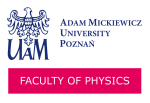24.2.2022
Driving research in quantum physics with machine learning and optical quantum information
prof. UAM dr hab. Karol Bartkiewicz
Date, Time
24.02, 15:00 - 16:00
Location
Link to MSTeams meeting
Classical programming means writing explicit instructions so that a program processes the input data and correctly answers our questions. Machine learning (ML) is a branch of artificial intelligence research that uses implicit programming, where the program does not receive explicit instructions. This method is particularly suitable for problems that are intuitive to humans but difficult to convert to set of machine instructions. Some complex problems resist known ML methods, especially in quantum systems [1,3]. E.g., designing new drug molecules or supervising quantum communication networks, which under certain assumptions should be protected from eavesdropping by the laws of quantum physics. These tasks quickly become unfeasible as the complexity of the problem increases. Solutions to such problems must be sought using quantum computing for ML [1,2]. This is the original motivation to combine ML and quantum physics [1]. However, there are many other reasons to do so. ML can be used to motivate theoretical and experimental research in quantum information, quantum state engineering, classification, and detection. To illustrate this, I will discuss a few assorted examples of combining ML and photonic quantum information processing, including [2,4,5,6,7]. These results include kernel and Hilbert-Schmidt distance-based methods, supervised and unsupervised learning, and deep artificial neural networks. I will focus on the cases, where deep ML provides new prospects for quantum physics research [7], including better quantum states classification than human-designed entanglement witnesses.
Keywords
optical quantum information, quantum machine learning, kernel trick, classification, clustering, Hilbert-Schmidt distance, variational quantum circuits, entanglement detection, artificial neural networks
References
- Biamonte, P. Wittek, N. Pancotti, P. Rebentrost, N. Wiebe, S. Lloyd, Nature 549, 195 (2017).
- Trávníček, K. Bartkiewicz, A. Černoch, K. Lemr, Phys. Rev. Lett. 123, 260501 (2019).
- Carleo, I. Cirac, K. Cranmer, L. Daudet, M. Schuld, N. Tishby, L. Vogt-Maranto,
L. Zdeborová, Rev. Mod. Phys. 91, 045002 (2019). - Bartkiewicz, C. Gneiting, A. Černoch, K. Jiráková, K. Lemr, F. Nori, Sci. Rep. 10, 12356 (2020).
- Jašek, K. Jiráková, K. Bartkiewicz, A. Černoch, T. Fürst, K. Lemr, Opt. Express 27, 32454 (2019).
- Trávníček, K. Bartkiewicz, A. Černoch, K. Lemr, Phys. Rev. Applied, 14, 064071, (2020).
- Roik, K. Bartkiewicz, A. Černoch, K. Lemr, Phys. Rev. Applied, 15, 054006, (2021)

